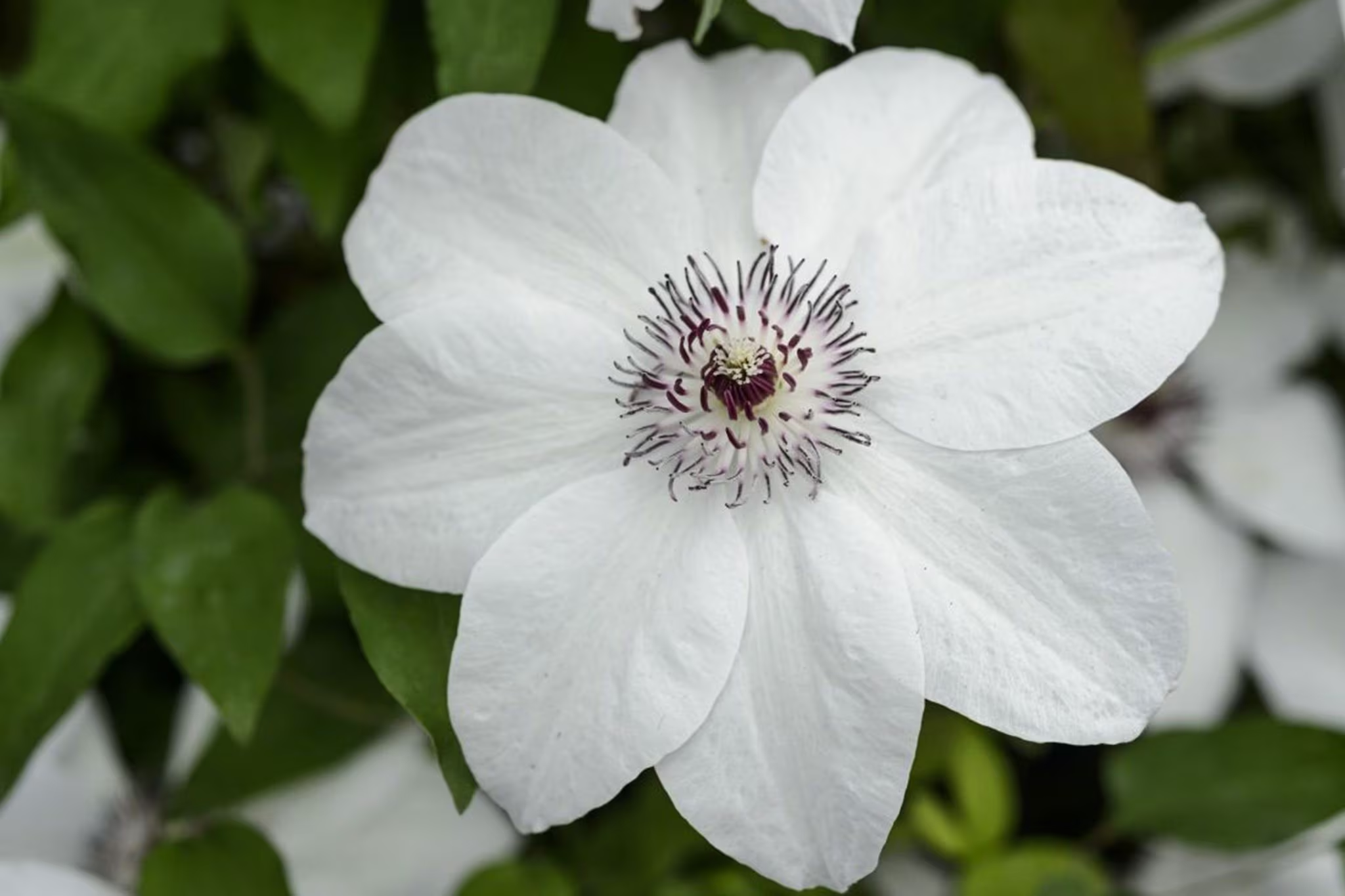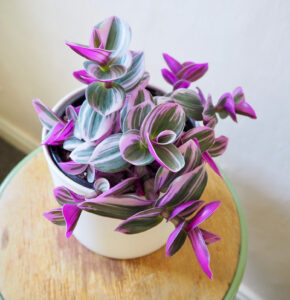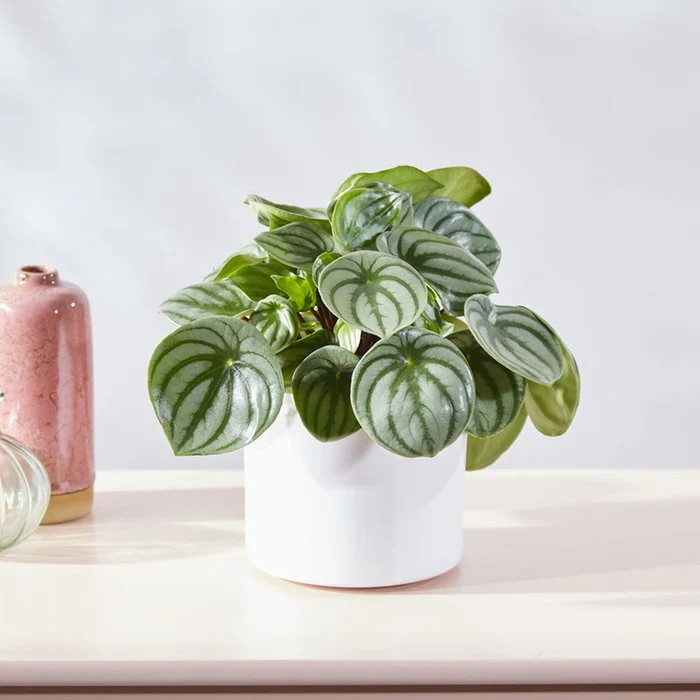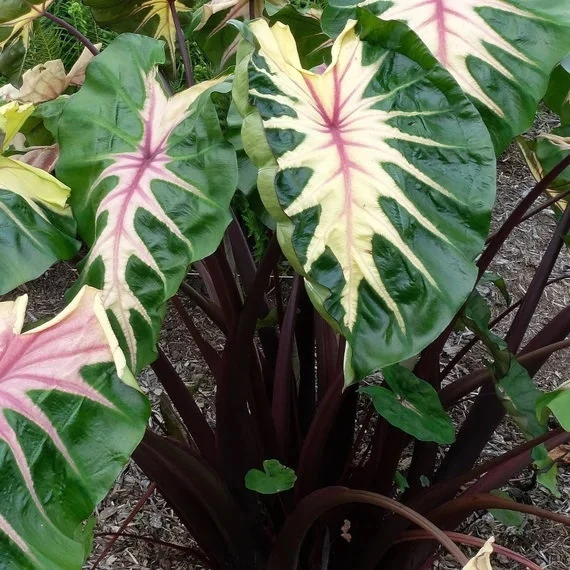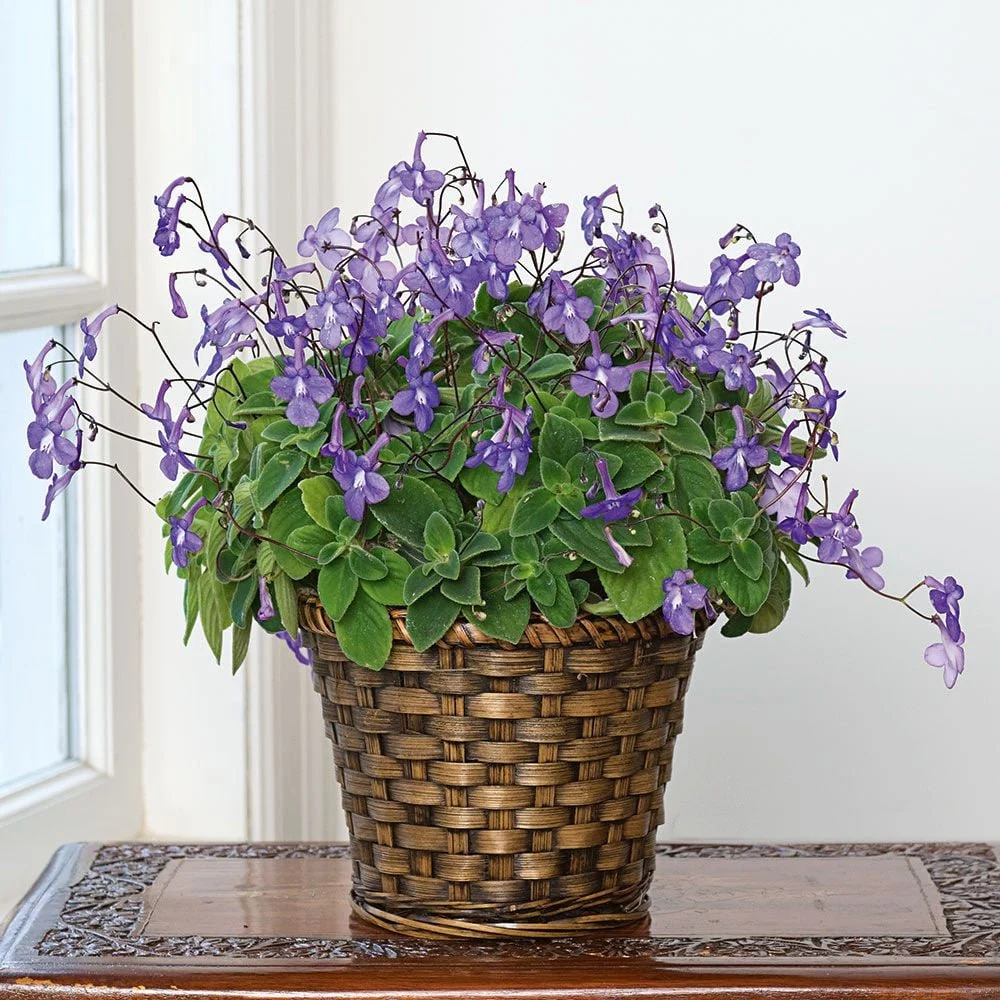Miss Bateman is a beautiful and popular cultivar of clematis, renowned for its striking white flowers with deep purple stamens that contrast beautifully against the creamy petals. This deciduous climbing vine is a favorite among gardeners due to its elegance, hardiness, and relatively easy care. It blooms prolifically in late spring to early summer, adding a graceful touch to any garden. Miss Bateman is perfect for trellises, fences, pergolas, or even as a ground cover for a more dramatic display.
Here’s a comprehensive care guide to help you grow and maintain a healthy Miss Bateman clematis.
1. Ideal Growing Conditions
To thrive, Miss Bateman needs specific environmental conditions.
Key Growing Conditions:
- Light: Clematis plants like Miss Bateman thrive in full sun to partial shade. Ideally, they should receive at least 6 hours of direct sunlight each day. Too much shade can reduce flowering, while too much direct sunlight (especially in hot climates) can scorch the flowers. Providing some afternoon shade can be beneficial in hotter regions.
- Temperature: Miss Bateman clematis is hardy in USDA hardiness zones 4-9, meaning it can withstand cold winters but also tolerate warm summers. It prefers moderate temperatures but can adapt to varying climates as long as the plant isn’t exposed to extreme heat or cold.
- Humidity: Clematis generally prefers a moderate level of humidity and good air circulation. Make sure the plant isn’t in a damp, stagnant spot, as this can promote fungal diseases.
2. Soil and Planting Requirements
The right soil is essential for the health of your Miss Bateman clematis.
Soil Requirements:
- Well-Draining, Moist Soil: Clematis plants like a moist, well-draining, slightly alkaline to neutral soil (pH of 6.0 to 7.5). Soil that holds moisture but doesn’t become waterlogged is key to preventing root rot.
- Loamy or Sandy Soil: A loamy or sandy soil mix works well for Miss Bateman, as it provides good drainage while holding enough moisture to support the plant’s needs.
- Soil Amendments: If your soil is heavy clay, amend it with organic matter like compost or well-rotted manure to improve drainage and structure.
Planting Tips:
- Planting Depth: When planting, ensure that the base of the clematis (where the roots meet the stem) is buried about 2-3 inches deeper than it was in the pot. This helps the plant develop strong root growth and reduces the risk of the plant becoming too top-heavy.
- Spacing: Clematis require plenty of space to grow. Space multiple plants about 2-3 feet apart to give them room to spread and climb.
3. Watering
Clematis require consistent moisture, but overwatering can cause problems.
Watering Guidelines:
- Consistent Moisture: Keep the soil evenly moist but not soggy. Water the plant thoroughly when the top inch of soil feels dry. Clematis roots are sensitive to drying out, so be sure to water consistently during dry spells.
- Avoid Wetting the Foliage: Water the base of the plant, avoiding wetting the leaves or flowers. Wet foliage can encourage fungal diseases, especially in humid environments.
- Mulching: Apply a layer of mulch around the base of the plant to retain moisture, keep the roots cool, and prevent weed growth. Use organic mulch like bark or compost.
4. Fertilizing
Fertilizing your Miss Bateman clematis encourages strong growth and abundant blooms.
Fertilizing Tips:
- Balanced Fertilizer: Use a balanced, slow-release fertilizer with equal parts nitrogen, phosphorus, and potassium (e.g., 10-10-10) or a specialized fertilizer for flowering plants. This provides the nutrients needed for both foliage growth and blooming.
- Feeding Schedule: Fertilize in early spring as the plant begins to grow, and again after the first round of flowers fades. In the fall, avoid fertilizing to allow the plant to enter dormancy.
- Organic Fertilizers: You can also use organic fertilizers, such as compost or well-rotted manure, to feed your clematis. Organic matter will also improve soil structure and moisture retention.
5. Pruning and Maintenance
Pruning Miss Bateman clematis is key to maintaining its shape and encouraging a better bloom display.
Pruning Tips:
- Pruning Group: Miss Bateman clematis belongs to Group 2 (also known as the Early Large-Flowering Clematis group). This means it blooms on both old and new wood. It benefits from light pruning in late winter or early spring to remove dead or damaged growth.
- Spring Pruning: In early spring, cut back any dead wood and trim the plant to encourage strong growth. You can prune back the previous year’s growth by about one-third to shape the plant and stimulate new growth for a better bloom display.
- Cutting Back After Blooming: Once the first flush of flowers has faded (usually around June), lightly trim the plant to remove any spent flowers and encourage a second round of blooms later in the season.
- Deadheading: Remove spent flowers after blooming to keep the plant tidy and prevent it from putting energy into seed production.
6. Pests and Diseases
Miss Bateman clematis, like all clematis plants, can be susceptible to certain pests and diseases.
Common Pests:
- Aphids: These small insects suck sap from the leaves, causing curling and yellowing. You can remove them with a strong spray of water or use insecticidal soap to treat infestations.
- Clematis Weevils: The larvae of clematis weevils feed on the roots, which can cause damage to the plant. To combat these pests, you may need to treat with a systemic insecticide or remove affected plants and debris from the soil.
- Spider Mites: These tiny pests can cause yellowing and speckling on leaves. Spider mites can be controlled with neem oil or insecticidal soap.
Common Diseases:
- Powdery Mildew: This fungal disease causes white, powdery spots on the leaves and stems. To prevent it, avoid overhead watering and ensure the plant has good air circulation. Use fungicides if necessary.
- Clematis Wilt: This is a fungal disease that causes wilting, yellowing, and browning of the leaves and stems. It usually affects the growing tips, and affected parts should be pruned off immediately. To prevent clematis wilt, avoid waterlogging the soil and ensure good air circulation.
- Root Rot: Overwatering or planting in poorly draining soil can cause root rot. Ensure proper drainage and avoid excessive watering.
7. Winter Care
In colder climates, Miss Bateman clematis will need some winter protection.
Winter Care Tips:
- Mulching: Apply a thick layer of mulch around the base of the plant in late fall to protect the roots from freezing. Use bark, straw, or leaves to insulate the plant.
- Cut Back: After the first frost, prune back any dead growth to the ground. This will help the plant conserve energy for the next growing season.
- Protecting from Frost: If you live in a region with very cold winters, consider covering the plant with a frost cloth or burlap to protect it from extreme cold and wind.
8. Propagation
You can propagate Miss Bateman clematis through cuttings or by dividing the plant.
Propagation by Cuttings:
- In late spring or early summer, take 4-6 inch cuttings from a healthy, non-flowering stem.
- Remove the lower leaves, leaving only the top 2-3 leaves.
- Dip the cut end in rooting hormone to encourage root development.
- Place the cutting in a pot with well-draining soil and water lightly.
- Keep the cutting in a warm, bright location with indirect light and mist it to maintain humidity.
- After several weeks, the cutting should develop roots and can be transplanted into a larger pot or garden bed.
Propagation by Division:
- Clematis can also be propagated by dividing the root ball in early spring or fall, although this is more challenging for Miss Bateman due to its delicate nature. If dividing, ensure each section has both roots and a healthy portion of stem.
Conclusion
Miss Bateman clematis is a stunning and versatile plant, perfect for adding elegance to your garden with its white flowers and striking purple stamens. With the right care—adequate sunlight, well-draining soil, consistent watering, and occasional pruning—your clematis will thrive, rewarding you with beautiful blooms each year. Whether trained on a trellis, fence, or allowed to sprawl as a ground cover, Miss Bateman is a plant that adds a touch of sophistication and color to any garden space.
Proudly powered by WordPress

